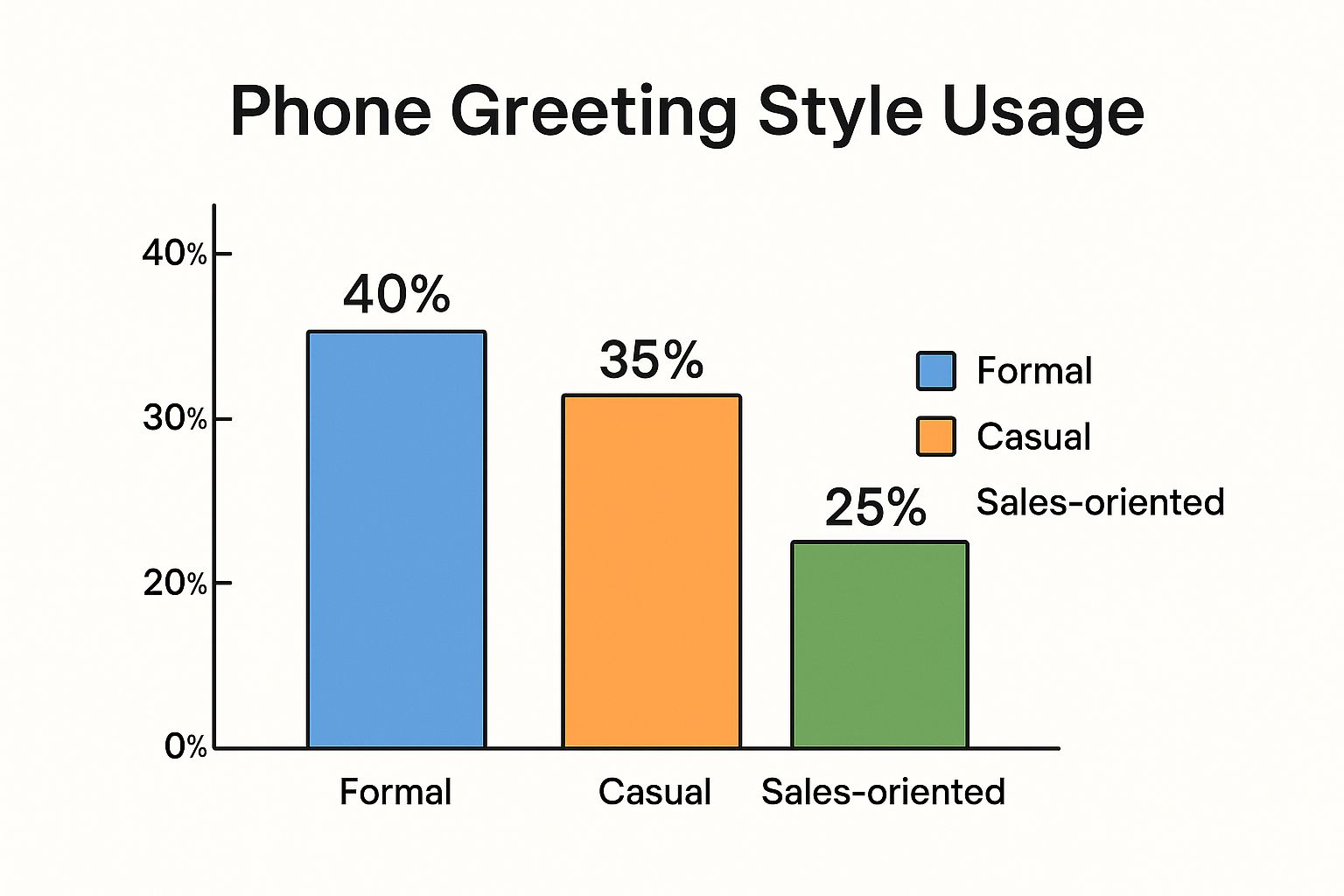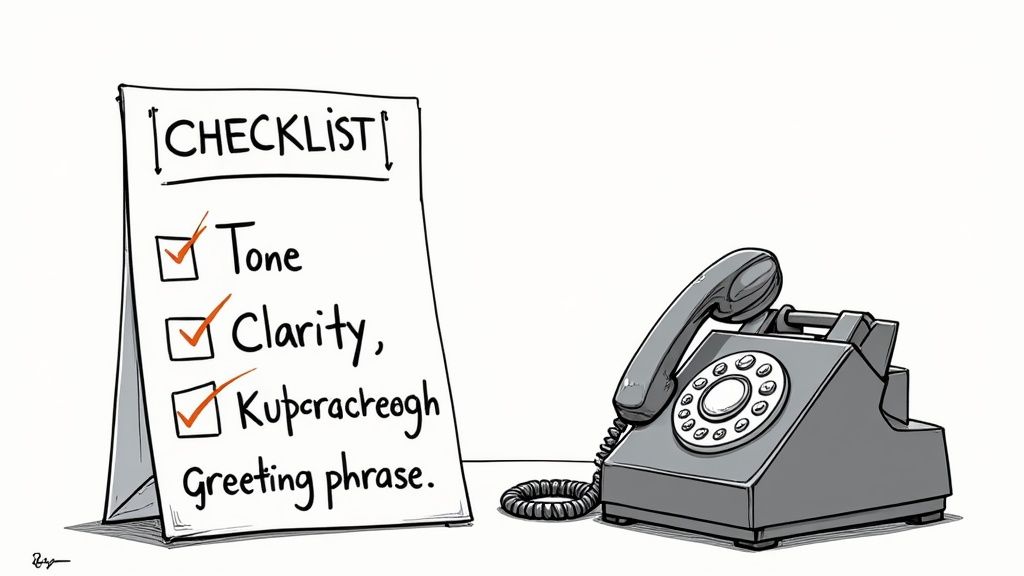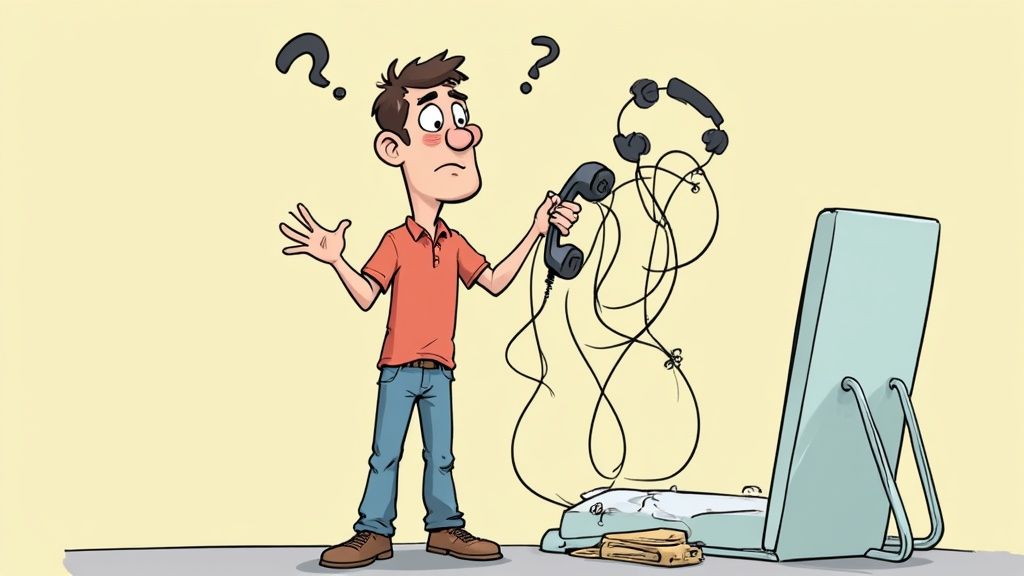A professional phone greeting is your brand’s verbal handshake. It’s the very first impression you make, setting the stage for the entire conversation and building a foundation of trust and competence in just a few seconds.
This isn't just about saying "hello." It's your one chance to shape how a caller sees your business before they even get to why they're calling.
Why Your Phone Greeting Is Your Brand's First Handshake
In a world full of automated texts and emails, the sound of a real human voice has become an incredibly powerful tool. That initial interaction—your greeting—is a critical moment that can define the entire customer experience. It’s your first, and sometimes only, shot at showing a customer you’re present, capable, and genuinely ready to help.
A warm, clear greeting does more than just make a good first impression. It has the psychological power to build immediate trust and can even de-escalate potential frustration right from the start. This single touchpoint says a lot about your company's values and can instantly set you apart from competitors who rely on impersonal automated systems or let calls roll to voicemail.
The Anatomy of a Perfect Phone Greeting
So what goes into a truly effective phone greeting? It's a simple formula, but getting it right consistently is what separates the pros from the amateurs. Think of it as having three core parts that work together to create a seamless and professional opening.
Here's a quick breakdown of what every great phone greeting should include:
| Component | Purpose | Example |
|---|---|---|
| Opening & Company Name | Immediately confirms the caller has reached the right place and sets a professional tone. | "Thank you for calling Sparkle Cleaners…" |
| Your Name | Personalizes the interaction and makes you accountable. It turns an anonymous call into a human conversation. | "…this is Michael speaking." |
| Offer of Assistance | Proactively shows you're ready to help and moves the conversation forward. | "How can I help you today?" |
Putting it all together, you get a simple, powerful, and professional greeting: "Thank you for calling Sparkle Cleaners, this is Michael speaking. How can I help you today?" It's quick, clear, and covers all the essential bases to start the call on the right foot.
The Lasting Impact of a Human Connection
While digital channels are convenient, never underestimate the importance of a classic phone call, especially for certain customers. Communication preferences vary a lot by age. While younger folks might lean towards texting, older groups (55+ years) still show a strong preference for mobile phone calls, with 35% in that bracket favoring it over other methods.
This insight, highlighted in a recent YouGov survey, underscores how vital it is to master your phone etiquette. You're serving a loyal and valuable customer segment that appreciates a direct, human conversation.
A welcoming voice can instantly transform a caller's frustration into a feeling of being understood. It’s not just about what you say, but the reassurance and competence conveyed in your tone from the very first second.
This chart shows how different industries tend to approach their greetings, giving you a sense of the common practices out there.

The data shows a fairly even split. A good number of businesses stick to formal greetings, but many others adapt, choosing more casual or sales-oriented openings that better fit their brand and industry.
Building Your Perfect Phone Greeting Script

Let's ditch the robotic, one-size-fits-all lines. The key to a genuinely great phone greeting isn't about memorizing a strict script. It's about having a few solid, adaptable building blocks you can piece together to fit any caller or situation. This way, you sound professional, authentic, and confident every single time.
Your goal is to build a greeting that feels like it actually comes from your brand. A formal financial institution should sound completely different from a laid-back creative studio. Your greeting has to reflect that reality.
The Core Components of a Greeting
Think of your script as having three essential parts. You can play with the specific words, but this core structure is what provides clarity and makes you sound like a pro.
- The Welcome: This is your opening. It can be a simple "Hello," a polite "Thank you for calling," or something with a bit more energy like, "Good morning!"
- The Identification: State your company name, then your own. This immediately tells the caller they’ve reached the right place and adds a necessary human touch. For instance, "You've reached Brightside HVAC, this is Sarah."
- The Offer: Wrap up with a proactive question that gets the ball rolling. "How can I help you?" is a classic for a reason—it’s direct, simple, and effective.
Put these three pieces together, and you have a rock-solid foundation. From there, it's all about tweaking the tone to match your business and the reason for the call.
Adapting Your Script to the Situation
Of course, your standard greeting won't be the perfect fit for every single call. A truly useful script needs to be flexible enough to handle whoever is on the other end of the line.
A great script isn’t a cage; it’s a framework. It provides structure so you can focus on the caller, not on what you’re supposed to say next. This freedom allows your natural warmth and professionalism to shine through.
Let's look at a couple of real-world scenarios:
Scenario 1: A Formal Corporate Setting
For a law office or an accounting firm, your greeting needs to project authority and competence right away.
- Greeting: "Thank you for calling Sterling & Price Associates. You're speaking with David. How may I direct your call?"
- Why it works: It's formal, direct, and uses precise language ("direct your call") that fits perfectly within a corporate environment.
Scenario 2: A Casual Service Business
Now, picture a local pet grooming salon. The tone here can—and should—be much warmer and more personal.
- Greeting: "Thanks for calling Pawsitively Perfect! This is Maria. How can I help you and your furry friend today?"
- Why it works: This is friendly, on-brand ("Pawsitively Perfect," "furry friend"), and makes the caller feel welcome from the first second.
The difference is all about understanding your brand's voice. Both greetings are professional, but they cater to completely different customer expectations. If you want to dive deeper, our guide on receptionist answering phone calls scripts is packed with more examples. Having a few go-to variations ready to deploy ensures you're prepared for whatever the day throws at you.
The Art of a Confident and Welcoming Delivery

Let's be honest: a perfect script is only half the battle. Without the right delivery, even the most carefully chosen words can sound robotic and impersonal. This is where the human element shines, turning a simple greeting into a genuine connection from the first word.
Your vocal tone carries a surprising amount of weight. It’s not just what you say, but how you say it. A warm, engaged voice immediately puts a caller at ease, while a flat or rushed tone makes them feel like an interruption. The goal is to sound present and professional, not like you're just reading off a screen.
Finding Your Confident Voice
Getting that natural and confident delivery down takes a little conscious effort, but it’s simpler than you might think. It actually starts with your physical presence—your posture and even your facial expression.
Here’s one of the most effective tricks in the book: smile before you speak. No, the caller can't see you, but they can absolutely hear a smile in your voice. It naturally lifts your pitch and injects a warmth that’s impossible to miss. This tiny change can completely shift the caller's first impression of your business.
A confident delivery is less about performance and more about presence. When you sound calm and clear, you signal to the caller that they've reached someone capable, building trust from the very first second.
You also need to pay attention to your pacing and enunciation. Mumbling your words or rushing through the greeting just creates instant frustration. It forces the caller to start with, "I'm sorry, who did you say this was?"—which is a terrible, inefficient way to begin an interaction.
To polish your delivery, try these simple exercises:
- Slow Down Just a Bit: Intentionally slow your speaking pace. This gives you room to enunciate every word clearly and makes you sound more thoughtful and in control.
- Take a Deep Breath: Before picking up the phone, take a calm breath from your diaphragm. It helps you project your voice without shouting and keeps you from sounding hurried or out of breath.
- Record Yourself: Use your phone to record yourself saying the greeting. When you play it back, do you sound friendly? Clear? It’s a fantastic way to spot and fix any issues you didn't know you had.
These techniques are essential for live calls, but they're just as critical when recording an after-hours message or voicemail. To make sure you're ready for those moments, you can learn more about how to properly leave a voicemail that upholds your professional standard.
Handling Tricky Real-World Greeting Scenarios

Let's be real—not every call comes in when it’s convenient. The phone always seems to ring right when you're in the middle of a delicate task, distracted, or putting out another fire. Knowing how to greet someone properly during these messy, real-world moments is what separates the pros from the amateurs.
Having a few go-to lines in your back pocket gives you the confidence to handle any call with grace. For example, if you get caught juggling tasks, a simple, "Thank you for calling. I'm with another customer right now, would you mind if I placed you on a brief hold?" works wonders. It's polite, professional, and it sets a clear expectation.
Greeting an Unknown or Immediate Transfer
What happens when the caller ID is blank or you have to transfer someone the second you pick up? Don't let it throw you. A calm, professional greeting is still your best move.
- For Unknown Callers: Stick with your standard opening but stay on your toes. A simple, "Good morning, this is Alex at Apex Solutions," is perfect. It’s professional without giving away too much information if it ends up being a cold sales call.
- For Immediate Transfers: Just let the caller know what’s happening. Try, "Thanks for calling, I'm transferring you to our specialist now. One moment, please." This is efficient and keeps the caller in the loop.
The goal is to never sound flustered, even when you are. Think of a steady, prepared greeting as your professional armor. It buys you a critical moment to collect your thoughts and take control of the conversation.
This need for fast, direct communication is a sign of the times. Just look at the explosive growth in mobile interactions. SMS volume shot up by over 7,700% in a decade, which tells you just how much customers value quick, direct responses in business.
Crafting the Perfect Voicemail Greeting
Your voicemail greeting is your 24/7 brand ambassador, so make it count. A great message gives callers the essential info they need so they aren’t left hanging.
Always include your name, your company, and one key piece of information, like your business hours or who to contact in an emergency. It's a small touch that makes a huge difference. For a deeper dive, check out our guide on call handling best practices.
How Voice and Text Greetings Work Together
Back in the day, a "greeting on the phone" was simple: a person answered and said hello. Today, your first touchpoint with a customer might be a live voice, but it could just as easily be an automated text message.
Understanding how to blend these digital and voice “handshakes” is crucial. The best tool for the job depends entirely on what you’re trying to accomplish.
For quick, efficient messages, a text can't be beat. Think about an appointment confirmation. An instant SMS provides immediate reassurance and delivers the necessary info without needing a full-blown conversation. It’s perfect for updates that aren’t emergencies.
But when things get complicated or emotional, the human voice is still king.
If a customer is calling with a burst pipe or a car that's broken down on the side of the road, a calm, competent voice on the other end of the line does more than any text ever could. It builds trust and conveys empathy in a way that plain text just can't match.
The Undeniable Power of SMS as a First Touch
From a business standpoint, using SMS for that initial greeting or follow-up is a no-brainer. The data tells the story pretty clearly.
SMS boasts a staggering 98% open rate—nearly five times higher than email. It also pulls in a 45% response rate, with people typically replying in just three minutes.
These aren't just vanity metrics. They show how powerful text is for getting a message seen and acted on fast. For non-urgent follow-ups or initial confirmations, it’s a channel that simply works. If you want to dive deeper, you can explore more data on SMS marketing effectiveness and see how it can support your voice strategy.
The smartest businesses don't choose one over the other; they use both strategically.
An automated SMS can instantly confirm a new appointment, freeing up a team member to make a follow-up voice call to discuss the important details. This creates a complete system where digital greetings handle the routine stuff, saving your most valuable asset—your voice—for the high-impact, personal conversations that solve real problems and build customers for life.
Answering Your Top Phone Greeting Questions
Even with the best scripts in hand, you'll run into those little nagging questions. The ones that pop up when you're actually on the phone, trying to put all this advice into practice. Getting these practical details right is what separates a good greeting from a great one.
Let's clear up some of the most common ones I hear.
How Long Should My Greeting Be?
Keep it short and sweet. Your whole greeting should wrap up in about 5-7 seconds. Think about it—the caller is on a mission. Your job is to give them the essential info (who you are, what company they've reached) without making them wait.
Something like, "Thank you for calling Apex Solutions, you're speaking with Maria. How can I help?" That's the sweet spot. It's quick, professional, and gets straight to the point.
Should I Say My Department?
Yes, absolutely—if it helps the caller. If your business has a general number where calls get routed to different teams, stating your department is a massive help. It prevents that awkward "Oh, I think I have the wrong person" moment.
Just adding, “You’ve reached Michael in the Sales department,” instantly tells the caller if they're in the right place or if they need a transfer. It’s a small detail that makes the whole experience smoother.
The biggest mistake I see? People either rush through their greeting or mumble. A garbled greeting just creates instant confusion and forces the caller to ask you to repeat yourself. It’s an inefficient and frustrating way to start any conversation.
Is It Okay to Sound a Little Casual?
This all comes down to your brand. "Professional" doesn't have to mean "robotic." For a lot of modern companies, a warmer, more relaxed tone actually builds a stronger connection with customers. It feels more human.
The key is to match your company's voice while always being respectful, clear, and ready to help. Authenticity often wins out over old-school formality.
Stop missing calls and losing business. Marlie Ai provides a 24/7 AI phone assistant that answers every call instantly, books jobs, and saves you hours every week. Discover how Marlie can transform your business today.

